|
|
|
Sort Order |
|
|
|
Items / Page
|
|
|
|
|
|
|
| Srl | Item |
| 1 |
ID:
162735
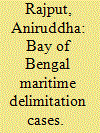

|
|
|
|
|
| Summary/Abstract |
At a time when there are instances of lack of participation in binding dispute resolution mechanisms under the UNCLOS, the Bay of Bengal Arbitrations provide a ray of hope and adherence to the rule of law. The three Bay of Bengal States: Bangladesh, India and Myanmar settled their long standing disputed claims over the maritime zones in the Bay of Bengal in a peaceful manner. These cases represent that States relatively stronger on the political level as compared to others are willing to compromise their positions and adhere to the outcome of dispute resolution proceedings under the UNCLOS. These cases involved sensitive issues such as the determination of the land boundary terminus, based upon the reports and other proceedings relating to the partition of India. There were other controversial claims over certain islands, which too were presented for adjudication and the decision was thereafter complied with all the parties to the dispute. These cases thus constitute a prime example of the importance of adherence to a rule based system for maritime claims.
|
|
|
|
|
|
|
|
|
|
|
|
|
|
|
|
| 2 |
ID:
162740
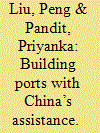

|
|
|
|
|
| Summary/Abstract |
China’s port development projects at home and abroad has generated much discussion among the scholars and policymakers. Since 5 of the top 10 container ports in the world are in mainland China and its shipping companies carry more cargo than those of any other nation, it points to the port efficiency and maritime infrastructure that China has developed in the recent years. However, some of China’s port development activities abroad have been subject of controversy pertaining to its intentions around these projects. In this backdrop, the paper seeks to analyse China’s port development initiatives from littoral countries’ perspective, given their critical dependence on ports such that the level of port efficiency affects the economic growth of the region. The study takes Bangladesh’s port development projects as an example to indicate the opportunities and challenges involved in such initiatives and the need to continue with port development program in a win-win cooperative framework.
|
|
|
|
|
|
|
|
|
|
|
|
|
|
|
|
| 3 |
ID:
162736
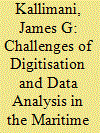

|
|
|
|
|
| Summary/Abstract |
The volume of collected and synthesised data available to governmental leaders assessing the maritime domain has increased rapidly over recent years. Analogue data has given way to digital data, which provides an opportunity for better storage, analysis and transfer. Data infusion and management has become the key constraint in respect of data collection. Using data to make decisions requires the appropriate tools and processes to assess and transfer data to near real-time user domains. In the maritime environment, there is a constantly growing demand for intelligence, surveillance and reconnaissance (ISR) data for both national security and commercial purposes, including data sharing among partner nations. However, an increase in available data does not automatically equate to an increase in decision-ready information. Rather, the increase in data can overwhelm sensors, databases and analysts. The concept and use of “big data” exacerbate the already overwhelming flow of data in terms of the volume, variety, and velocity of the data being received. This paper will explore the digitisation of the maritime domain, and the prospect of performing data analysis in a world of rapidly growing data.
|
|
|
|
|
|
|
|
|
|
|
|
|
|
|
|
| 4 |
ID:
162733
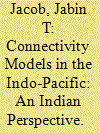

|
|
|
|
|
| Summary/Abstract |
China’s Belt and Road Initiative (BRI) is often sold as a project that aims to meet the infrastructure deficit in many underdeveloped parts of the world. However, Chinese projects under the BRI come with features that have negative short-term and long-term implications for the host countries in question. Chinese project financing almost uniformly lacks transparency, including about the terms of this financing, and is accompanied by uncertainty about local benefits such as employment and by poor standards. This paper begins by highlighting some key features of Chinese infrastructure projects under the BRI, before it examines, in detail, the financing of these projects, particularly in South Asia. The article concludes by stating that China’s success in pushing the BRI – despite its several problems – is the result of the inability of democratic nations to come up with feasible alternatives that respect local sensitivities and conditions in the countries in need of infrastructure development. India, especially, has much to reflect upon in respect of its own methods and approaches towards its neighbours and towards overseas development assistance in the wake of China’s BRI.
|
|
|
|
|
|
|
|
|
|
|
|
|
|
|
|
| 5 |
ID:
162738
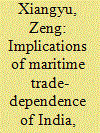

|
|
|
|
|
| Summary/Abstract |
India, China and Japan, the economic big three in Asia, is heavily dependent on maritime trade in terms of importation of energy and other natural resources in addition to import/export of manufactured products. Major economic, political and security impact has been resulted from such a dependence, as the sea-lines of communication for maritime trade across the Indian Ocean and West Pacific is vulnerable to heavy conventional/unconventional threat. Policy measures have been taken in order to mitigate the vulnerabilities. Accelerated development of maritime powers, bilateralism/multilateralism, enhanced engagement with regional players and diversification policies are among such effort. The unconventional challenges are on the decline, partly thanks to effective counter-measures, while the conventional challenges is on the rise, also partly due to the mis-match of policies from major stakeholders. The Rise of Indo-Pacific Concept and the Emerging Maritime Regionalism can be a double-edge sword. Clarification of strategic intention and effective policy dialogue is needed for a more harmonious maritime engagement among the three. Strategic vision and smart policies are needed to ensure a cooperation for the benefit of all stakeholder inclusive of the three countries in particular.
|
|
|
|
|
|
|
|
|
|
|
|
|
|
|
|
| 6 |
ID:
162737


|
|
|
|
|
| Summary/Abstract |
While maritime merchandise trade brings about significant opportunities for growth in Southeast Asia, the dependency on maritime merchandise trade also brings about risks and challenges. This paper begins with a brief examination of the maritime merchandise trade situation globally and in Southeast Asia, followed by a discussion of initiatives undertaken to promote maritime merchandise trade in the region. In doing so, the paper makes three key propositions. First, concentration of trade among a few trading partners and the large maritime infrastructure and logistics gap among the Association of Southeast Asian Nations (ASEAN) member states are the two main challenges facing Southeast Asia. Second, case studies of Indonesia and Singapore show that diverse interests and capabilities among ASEAN member states underscores the need for different national strategies for promoting maritime merchandise trade. Third, both traditional and non-traditional maritime security threats constitute significant risk to maritime merchandise trade in Southeast Asia.
|
|
|
|
|
|
|
|
|
|
|
|
|
|
|
|
| 7 |
ID:
162739
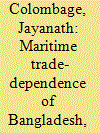

|
|
|
|
|
| Summary/Abstract |
Maritime trade is a key contributor to economy in many countries particularly those that are bordering on oceans. Sri Lanka is geographically located in proximity to the main East-West sea route creating multiple logistics advantages to the adjunct countries. This paper considers the maritime trade dependence between Bangladesh, Myanmar and Sri Lanka that focuses on potential implications and a futuristic view. The paper primarily provides an appraisal of maritime trade about Bangladesh, Myanmar, and Sri Lanka. Thereafter, it identifies the historical connections between these countries and discusses the related developments and implications in the maritime industry. It consists of a review and comparison of shipping performance of the countries and an appraisal of Logistics Performance. In addition, it provides an indication of the global perception about other key factors pertaining to logistics and transport. Port project developments, One Belt One Road Initiative, maritime security, risk of Cyber-attacks, a rule based maritime order, trade and investment, transport, energy, and tourism are other factors that are highlighted in this paper.
|
|
|
|
|
|
|
|
|
|
|
|
|
|
|
|
| 8 |
ID:
162734


|
|
|
|
|
| Summary/Abstract |
This paper reviews the existing multilateral structures in the Indian Ocean Region (IOR) – notably the Indian Ocean Rim Association (IORA) – in the context of various geopolitical facets, ranging from geoeconomics to regional security and good order. It examines and recommends options to bolster economic multilateralism in the IOR though a comprehensive two-fold approach. The first one seeks to enhance intraregional trade, maritime–economic connectivity, and technology sharing, delving into issues relating to a region-wide free trade agreement (FTA), the amalgamation of economic corridors within IORA, and the “Make in India” initiative. The second is founded upon the indispensability of a secure and conducive maritime environment for economic development, and addresses maritime safety and security (MSS), as also “good order” in the IOR. It suggests measures to bolster the IORA’s nascent MSS architecture with a web of bilateral, trilateral and subregional mechanisms, emphasising the Indian Ocean Naval Symposium (IONS) as the key functional enabler of IORA’s MSS agenda. It also examines the imminent challenges relating to freedom of navigation (FoN), and undertakes an appraisal of Sri Lanka’s draft Code of Conduct (CoC) for the Indian Ocean. The arguments presented hinge upon the suggestion that the collective approach of the IOR countries should ideally be in consonance with India’s prime-ministerial enunciation of the concept of SAGAR – security and growth for all in the region. If each Indian Ocean country’s economy is a “boat”, the Indian “boat” cannot rise unless all “boats” rise with a rising economic tide.
|
|
|
|
|
|
|
|
|
|
|
|
|
|
|
|
|
|
|
|
|